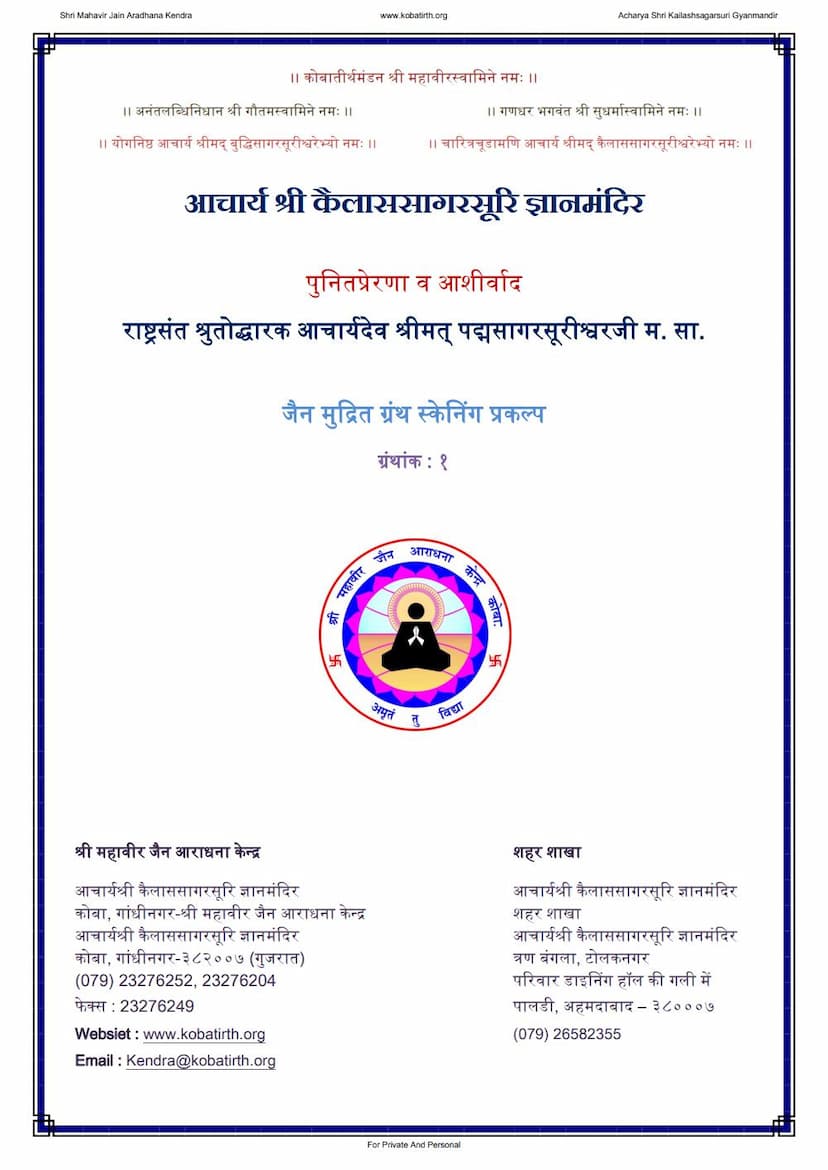Agam 05 Ang 05 Bhagvati Vyakhya Pragnapti Sutra Part 03 Shwetambar
Added to library: September 1, 2025

Summary
The provided text is a segment of the Jain Bhagvati Sutra, specifically Ang 05, Sutra 05, Part 03, authored by Purnachandrasagar and published by Jainanand Pustakalay. This particular volume is part of the Shwetambar tradition. The text itself is a detailed discourse and elaboration on various aspects of Jain philosophy and practice, presented in a question-and-answer format between Lord Mahavir and his disciple Gautama Swami (Gaṇadhara Bhagavanta Shri Sudharmaswami).
The content is highly technical and covers a vast range of topics within Jain cosmology, karmic theory, and spiritual progression. Here's a breakdown of the key themes and concepts encountered in the provided pages:
Core Jain Concepts and Discussions:
- Soul and Rebirth (Uvavajja): A significant portion of the text discusses the transmigration of souls (
Uvavajja). It details the destinations of souls after death based on their past actions, karmic accumulations, and present state, including various hellish realms (Neraiya), celestial realms (Deva), and animal realms (Tiriyanch). The text meticulously outlines the conditions and durations of rebirth in different lokas and specific planetary systems. - Karmic Theory (Karma): The intricate workings of karma (
Karma) are a central theme. The text explains how karmic particles (Pudgala) are attracted, bound, and how they influence the soul's journey through different lifetimes. Different types of karma, their duration, and their effects are elaborated upon. - Matter and Soul (Dravya): The nature of substances (
Dravya) is discussed, particularly the distinction between living substances (Jiva Dravya) and non-living substances (Ajiva Dravya). The interaction and influence of these substances on the soul are explored. - Sentient and Non-sentient Beings: The text classifies beings based on their number of senses (
Indriya) and their level of sentience, from one-sensed beings (Ekendriya) to five-sensed beings (Paṇchendriya). It also delves into the existence of beings with subtle bodies and those without. - Cosmic Structure (Lokakasha): The text touches upon the structure of the universe (
Lokakasha), its dimensions, and the entities that populate it. The concept of space-time (Kāla,Kṣetra,Bhāva) and their role in the soul's journey is also present. - Spiritual Paths and Stages (Samyama, Yoga, Bhāva): Discussions on ethical conduct (
Samyama), mental discipline (Yoga), and mental states (Bhāva) are integral. The text describes the various stages of spiritual progress and the conditions that lead to liberation (Siddhi). - Classification and Categorization: A hallmark of the Bhagvati Sutra is its exhaustive classification of phenomena. This segment includes detailed categorizations of:
- Types of Bodies: From gross bodies (
Oraḷiya) to subtle (Tejas,Karmana) and even the conceptualizedVaikriyābodies. - Types of Senses: From touch (
Sparśendriya) to mind (Manoyoga). - Types of Karma: As mentioned above, the intricacies of karmic bondage and its types are detailed.
- Types of States of Mind (Bhāva): Including emotions, passions, and mental dispositions.
- Stages of Consciousness (Upayoga): From gross awareness to the subtle states leading to omniscience.
- Levels of Purity and Impurity (Leśyā): The six
Leśyās(black, blue, grey, yellow, red, white) are discussed in relation to karmic influx. - Knowledge and Ignorance: Different types of knowledge (
Nāna) and ignorance (Ajñāna) are explained. - Causality and Actions: The text delves into the cause and effect relationship in actions (
Kriya) and their consequences.
- Types of Bodies: From gross bodies (
- Specific Examples and Narratives: While the primary mode is philosophical discourse, the text incorporates examples, such as the rebirth of Lord Udayi as an elephant king, to illustrate complex concepts.
- Historical Context of Agamas: Some pages provide insights into the historical process of compilation and preservation of Jain scriptures (
Agamas) through variousVachanās(recensions or councils). This historical perspective highlights the importance of knowledge transmission and safeguarding. - Emphasis on the Soul's Agency: Throughout the text, there is a consistent emphasis on the soul's own actions and karma as the primary determinants of its fate, rather than external forces.
Structure and Style:
The text is characterized by:
- Scholarly Depth: It displays profound knowledge of Jain metaphysics, cosmology, and ethics.
- Logical Progression: The questions and answers are structured to build upon each other, systematically dissecting complex topics.
- Technical Terminology: It uses specific Jain philosophical and cosmological terms that require a knowledgeable reader or translator to fully grasp.
- Enumeration and Classification: The text frequently enumerates and classifies concepts into various categories, often numbering them for clarity.
Overall Purpose:
The Bhagvati Sutra, as evidenced by this segment, aims to provide a comprehensive understanding of the Jain worldview, guiding individuals towards spiritual liberation by explaining the principles of karma, the nature of reality, and the path to overcoming worldly attachments and suffering. The specific volume discussed here, being Part 03, likely continues the detailed exposition of subjects introduced in earlier parts, such as the fundamental principles of Jainism.
In essence, this text is a profound theological and philosophical work within Jainism, offering detailed explanations of its cosmology, karmic laws, and the soul's journey, presented through the lens of the teachings of Lord Mahavir.